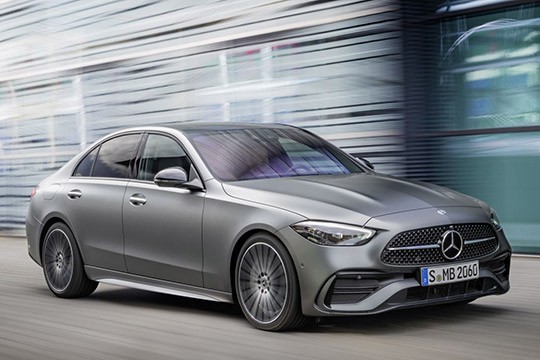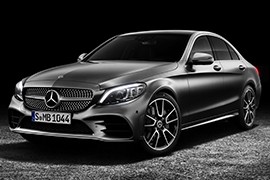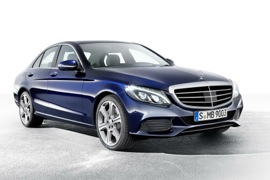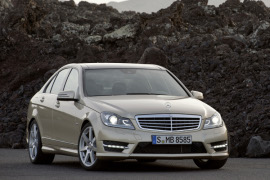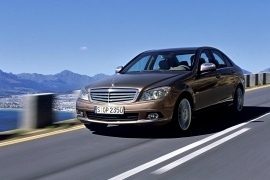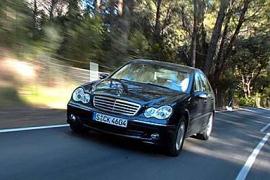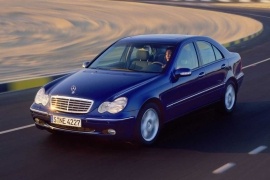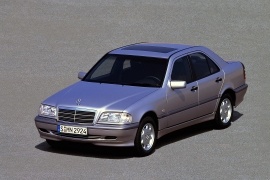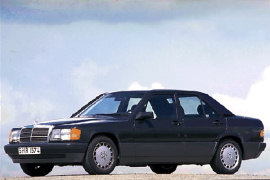MERCEDES BENZ C-Klasse and predecessors Models/Series Timeline, Specifications & Photos
First production year: 1982
Engines: Mild hybrid, Mild hybrid diesel, Gasoline, Diesel, Hybrid gasoline, Plug-in hybrid
In 2021, Mercedes-Benz introduced the fifth-generation for one of its best-selling ranges, the C-Class, and pushed forward the company's electrification process.
While the world was still fighting against the pandemic situation, Mercedes-Benz had to push forward toward a cleaner future. Its new range was developed from the ground up and introduced advanced technologies such as rear-axle steering and, as a first for the C-Class, plug-in hybrid versions.
With its cab-rearward design proportion, the C-Class featured a longer front end when compared to its overall length. The A-pillars were sloped even more when compared to its predecessor, and the decklid was even shorter. Combined with the power-domes on the hood and the tear-shaped headlights, all these created a sportier appearance for the mid-size sedan. In the back, the LED taillights followed an aggressive design with sharp sides on the inboard section, which crossed from the quarter panels to the trunk lid.
Inside, the C-Class designers took their inspiration from the S-Class. They created a dashboard divided into an upper and lower section. There were new, flattened round vents reminiscent of aircraft engines. The driver area featured a high-resolution, free-standing LCD screen. Customers have a choice between a 10.25" or a 12.3" version. On the center stack, Mercedes-Benz installed another big display tilted toward the driver for the infotainment system, with a standard 9.5" touch-screen and an option for an 11.9".
Under the hood, the C-Class W206 started its journey with a new engine lineup. Its downsizing process, combined with the electrification program, led to higher fuel-efficiencies for the entire lineup. At the new generation's start, the car received only automatic transmissions and rear-wheel-drive systems.
Mercedes-Benz introduced in 2018 a mid-life cycle refresh for its best-selling model from those times, the C-Class W205, adding more value to an already appreciated car.
After switching from a conservative look to a younger, fresh appearance, the C-Class increased its sales. More youthful customers were no longer afraid that if they get behind the wheel of a C-Class, they'll be accused of stealing their grandparents' car. But, after four years on the market, the compact-executive sedan needed some upgrades to look fresh again.
The entire range received a new front fascia, with LED headlights and an option for an ultra range system, with up to 84 individual LEDs inside. Its grille lost the three-slats from its non-facelifted version and gained a 3D mesh with a horizontal slat and a wide three-pointed-star badge. It lost the little star from the hood, though.
The interior went through a major upgrade along with the introduction of the new infotainment system and an option for a full-digital instrument panel with three individual display options. Its touch-sensitive controls from the steering wheel allowed the driver to access the infotainment unit and also access the LINGUATRONIC voice-control system.
Along with the facelifted version, Mercedes-Benz introduced the 2.0-liter turbo-diesel engine on the C-Class. It was carried over from its bigger brother, the E-Class. The engine lineup ranged from a fuel-efficient 1.6-liter turbo-diesel that provided 122 hp to an inline-six turbocharged three-liter unit that pumped 333 hp to a standard nine-speed automatic gearbox.
MERCEDES BENZ C-Class (W205) C 180d 6MT (122 HP)
MERCEDES BENZ C-Class (W205) C 180d 9AT (122 HP)
MERCEDES BENZ C-Class (W205) C 200d 6MT (150 HP)
MERCEDES BENZ C-Class (W205) C 200d 9AT (150 HP)
MERCEDES BENZ C-Class (W205) C 220d 9AT (195 HP)
Longer, lighter, and more luxurious than its predecessor, the W205 C-Class was introduced in 2014, and it was a gamechanger in the compact premium market.
The car carried over elements from the S-Class, making its occupants feel spoiled even though it was priced well below its luxurious sibling. Since it used many aluminum parts, it weighed 220 lbs (100 kg) less than the W204 C-Class it replaced. Mercedes-Benz tried to impress with its new model, and it nailed it. After all, the C-Class deserved all of that since it was the best-selling range from the automaker's stable.
With its fresh-looking exterior, the 2014 C-Class featured a sporty appearance. At the front, depending on the options, it sported an aerodynamically-profiled bumper and swept-back headlights with rounded corners. As an option, the automaker offered an AMG package that changed the car's look thanks to an aggressive-looking bumper and wider wheels. From its profile, the W205 featured sculptured door panels with curved surfaces and carved concave areas. It looked sporty thanks to its cab-rearward design and the short rear deck.
The interior followed the same philosophy as the exterior but with many options available. Since Mercedes-Benz was already focused on sustainability, it used Artico faux leather on the seats and the steering wheel. Furthermore, customers could opt for aluminum trims and piano-black finishes. Atop the center stack, the automaker installed the infotainment's unit screen in a free-floating position. The sporty feeling offered by the car was emphasized by the bolstered bucket seats at the front, but they still proved to be comfy as well. In the rear, the bench seat contoured for two adults provided enough room for three. However, the tall transmission tunnel drastically limited the legroom.
The automaker stepped-up its game in the premium-compact segment and offered the W205 with a wide choice of diesel, gasoline, or hybrid powerplants. Both rear-wheel drive and all-wheel drive options were on the table, with manual or seven-speed automatic transmissions.
MERCEDES BENZ C-Class (W205) 400 4MATIC 7AT AWD (329 HP)
MERCEDES BENZ C-Class (W205) C 180 6MT RWD (156 HP)
MERCEDES BENZ C-Class (W205) C 180 7AT RWD (156 HP)
MERCEDES BENZ C-Class (W205) C 200 6MT RWD (184 HP)
MERCEDES BENZ C-Class (W205) C 200 7AT RWD (184 HP)
MERCEDES BENZ C-Class (W205) C 250 7AT RWD (211 HP)
MERCEDES BENZ C-Class (W205) C 180 BlueTEC 6MT RWD (116 HP)
MERCEDES BENZ C-Class (W205) C 200 BluTEC 6MT RWD (136 HP)
MERCEDES BENZ C-Class (W205) C 220 BlueTec 6MT RWD (170 HP)
MERCEDES BENZ C-Class (W205) C 220 BlueTec 7AT RWD (170 HP)
MERCEDES BENZ C-Class (W205) C 220 BlueTEC BlueEFFICIENCY 7AT RWD (163 HP)
MERCEDES BENZ C-Class (W205) C 250 BlueTEC 4MATIC 7AT AWD (204 HP)
MERCEDES BENZ C-Class (W205) C 300 BlueTEC HYBRID 7AT AWD (231 HP)
Mercedes-Benz refreshed the entire C-Class lineup in 2011, and the difference was not subtle at all, with a completely redesigned front fascia.
The third generation of the C-Class was introduced on the market in 2007, which was a significant change compared to its predecessor. More than 2000 parts were changed or improved. It was the generation that brought back the traditional, angular-shaped headlights for the premium-compact contender of the German carmaker. Yet, four years later, the three-pointed-star brand decided to try an unconventional look again.
With the refreshed version, Mercedes-Benz tried an unusual shape for the C-Class' headlights again. They were swept back towards the upper side of the fenders. Yet, apart from the front fascia, there were hardly any significant differences on the exterior.
Inside, Mercedes-Benz completely changed the dashboard, which now featured an in-dash screen for the infotainment system, placed atop the center stack in a neatly integrated cluster. On the pre-facelifted version, it used a pop-out screen that had raised from inside the dashboard. Among other changes, the carmaker replaced the steering wheel, which lost the round-shaped layout for the buttons, and introduced the squared pattern for them.
From a technical point of view, Mercedes-Benz introduced the upgraded version of the seven-speed automatic gearbox, named 7G-Tronic Plus, which solved some of the problems encountered in the regular 7G-Tronic unit used before. Last but not least, the carmaker introduced new, direct fuel-injected turbocharged gasoline engines on the C-Class that lowered emissions and improved fuel efficiency.
MERCEDES BENZ C-Klasse (W204) 180 CDI BlueEFFICIENCY 7AT RWD (120 HP)
MERCEDES BENZ C-Klasse (W204) 200 CDI BlueEFFICIENCY 7AT RWD (136 HP)
MERCEDES BENZ C-Klasse (W204) 220 CDI BlueEFFICIENCY Edition 6MT RWD (170 HP)
MERCEDES BENZ C-Klasse (W204) 220 CDI BlueEFFICIENCY Edition 7AT RWD (170 HP)
MERCEDES BENZ C-Klasse (W204) 250 CDI BlueEFICIENCY 4Matic 7AT AWD (204 HP)
MERCEDES BENZ C-Klasse (W204) 250 CDI BlueEFICIENCY 7AT RWD (204 HP)
MERCEDES BENZ C-Klasse (W204) C 180 CDI 6MT RWD (120 HP)
MERCEDES BENZ C-Klasse (W204) C 200 CDI 6MT RWD (136 HP)
MERCEDES BENZ C-Klasse (W204) C 220 CDI 6MT RWD (170 HP)
MERCEDES BENZ C-Klasse (W204) C 250 CDI 7AT RWD (204 HP)
The third generation of the C-Class debuted at the 2007 Geneva Motor Show and it showed a new design for the entire range, in the same style with its bigger brothers, the E-Class and the S-Class.
The 2007 model lost the four-round headlights style from its predecessor and returned to a more common square design. It was built to offer more comfort than a medium-sized sedan from other mass-market brands. When compared to its predecessor, the W203, it featured a 50 mm (2”) longer wheelbase, to offer more legroom for the rear passengers.
The sportier look of the car was considered appealing by younger generations who didn't consider to buy a Mercedes-Benz before. The new design was part of its big success. It was the best sold Mercedes-Benz from its era, with a total of 2.4-million units sold. The square, angular, headlights, the body-colored door handles and the sculptured profile were part of the W204 success story.
Inside, there were new features that were appealing to the younger generation. The Mercedes designers took their lead from the sporty sector and included dial gauges such as those found in roadsters or coupes. The new infotainment options started with the Audio 20 and went all the way up to the multimedia Command APS that featured a 7” color screen display with navigation. All versions featured Bluetooth connectivity.
For the technical point of view, all the range was fitted as standard with a 6-speed manual gearbox but the 350 version, which was fitted with a 7G-Tronic automatic gearbox. That was offered as an option for the rest of the stable.
MERCEDES BENZ C-Klasse (W204) 180 CGI 5AT RWD (156 HP)
MERCEDES BENZ C-Klasse (W204) 180 CGI 6MT RWD (156 HP)
MERCEDES BENZ C-Klasse (W204) 180 K BlueEFFICIENCY 5AT RWD (156 HP)
MERCEDES BENZ C-Klasse (W204) 180 K BlueEFFICIENCY 6MT RWD (156 HP)
MERCEDES BENZ C-Klasse (W204) 180 Kompressor 5AT RWD (156 HP)
MERCEDES BENZ C-Klasse (W204) 180 Kompressor 6MT RWD (156 HP)
MERCEDES BENZ C-Klasse (W204) 200 CGI 5AT RWD (184 HP)
MERCEDES BENZ C-Klasse (W204) 200 CGI 6MT RWD (184 HP)
MERCEDES BENZ C-Klasse (W204) 200 Kompressor 5AT RWD (184 HP)
MERCEDES BENZ C-Klasse (W204) 200 Kompressor 6MT RWD (184 HP)
MERCEDES BENZ C-Klasse (W204) 230 V6 6MT RWD (204 HP)
MERCEDES BENZ C-Klasse (W204) 230 V6 7AT RWD (204 HP)
MERCEDES BENZ C-Klasse (W204) 250 CGI 5AT RWD (204 HP)
MERCEDES BENZ C-Klasse (W204) 280 V6 6MT RWD (231 HP)
MERCEDES BENZ C-Klasse (W204) 280 V6 7AT RWD (231 HP)
MERCEDES BENZ C-Klasse (W204) 300 V6 6MT RWD (231 HP)
MERCEDES BENZ C-Klasse (W204) 300 V6 7AT RWD (231 HP)
MERCEDES BENZ C-Klasse (W204) 200 CDI 5AT RWD (136 HP)
MERCEDES BENZ C-Klasse (W204) 200 CDI 6MT RWD (136 HP)
MERCEDES BENZ C-Klasse (W204) 220 CDI 5AT RWD (170 HP)
MERCEDES BENZ C-Klasse (W204) 220 CDI 6MT RWD (170 HP)
MERCEDES BENZ C-Klasse (W204) 250 CDI 6MT RWD (204 HP)
The mid-life refresh for the second generation of the Mercedes-Benz C-Class brought more power for the engines, exterior, and interior changes.
The C-Class was a success from its start and the second generation was launched in March 2000 at the Geneva Motor Show. Four years later, the facelift appeared with important changes for especially for the diesel versions, which were upgraded from Euro 3 emission standard to the Euro 4. That change added some power, but it also lost the only AMG diesel version.
From the outside, new headlights, new rear-view mirrors, and taillights were added to the car. The body shape remained the same, with only some subtle changes.
Inside, the instrument cluster was completely redesigned. Instead of a big, large, speedometer in the middle as in the pre-facelift version, the 2004 C-Class featured two round dials for the speedometer and the tachometer. Between them, there was an LCD display for the on-board computer. Also, the steering wheel was redesigned, with round buttons instead of larger, squared ones.
For the engine compartment, the 2.1-liter diesel engine was offered with up to 150 hp. The C30 CDI was cut out of the production line. For the gasoline units, there was more power for the supercharged engines. The standard transmission was a 6-speed manual while a 5-speed automatic was offered as an option. Also, 4Matic all-wheel-drive versions were upgraded.
MERCEDES BENZ C-Klasse (W203) 180 Kompressor 5AT RWD (143 HP)
MERCEDES BENZ C-Klasse (W203) 180 Kompressor 6MT RWD (143 HP)
MERCEDES BENZ C-Klasse (W203) 200 Kompressor 5AT RWD (163 HP)
MERCEDES BENZ C-Klasse (W203) 200 Kompressor 6MT RWD (163 HP)
MERCEDES BENZ C-Klasse (W203) 230 Kompressor 5AT RWD (192 HP)
MERCEDES BENZ C-Klasse (W203) 230 Kompressor 6MT RWD (192 HP)
MERCEDES BENZ C-Klasse (W203) 230 V6 6MT RWD (204 HP)
MERCEDES BENZ C-Klasse (W203) 230 V6 7AT RWD (204 HP)
MERCEDES BENZ C-Klasse (W203) 240 V6 4MATIC 5AT AWD (170 HP)
MERCEDES BENZ C-Klasse (W203) 240 V6 5AT RWD (170 HP)
MERCEDES BENZ C-Klasse (W203) 240 V6 6MT RWD (170 HP)
MERCEDES BENZ C-Klasse (W203) 280 V6 4MATIC 5AT AWD (231 HP)
MERCEDES BENZ C-Klasse (W203) 280 V6 6MT RWD (231 HP)
MERCEDES BENZ C-Klasse (W203) 280 V6 7AT RWD (231 HP)
MERCEDES BENZ C-Klasse (W203) 320 V6 4MATIC 5AT AWD (218 HP)
MERCEDES BENZ C-Klasse (W203) 320 V6 5AT RWD (218 HP)
MERCEDES BENZ C-Klasse (W203) 320 V6 6MT RWD (218 HP)
MERCEDES BENZ C-Klasse (W203) 350 V6 4MATIC 5AT RWD (272 HP)
MERCEDES BENZ C-Klasse (W203) 200 CDI 5AT RWD (122 HP)
MERCEDES BENZ C-Klasse (W203) 200 CDI 6MT RWD (122 HP)
MERCEDES BENZ C-Klasse (W203) 220 CDI 5AT RWD (150 HP)
MERCEDES BENZ C-Klasse (W203) 220 CDI 6MT RWD (150 HP)
MERCEDES BENZ C-Klasse (W203) 270 CDI 5AT RWD (170 HP)
MERCEDES BENZ C-Klasse (W203) 270 CDI 6MT RWD (170 HP)
The second-generation C-Class saw the arrival of a completely redesigned vehicle with a longer, curvier nose and a sportier, shorter rear. It was introduced in March 2000 to replace the previous legendary W202. It came in an era of transition when Mercedes decided to try something new in design and technology.
Inside the cabin, Mercedes-Benz used top-quality materials and plenty of options. There are two options for the automatic climate-control unit, CD-Radio or Navigation Systems, Bluetooth to connect a phone or a cradle where the driver can plug in a phone. The central armrest is refrigerated.
The manufacturer offered heating and ventilation systems with dedicated air vents for the rear-seat passengers. A lot of goodies from a premium brand, but there are also a few downsides.
If you are not very familiar with Mercedes, the parking brake might feel a bit odd, being the third pedal if you have an automatic gearbox and the fourth pedal if you have a manual. Unfortunately, even if it is a well-built car, the rust problems stay close to this model, especially if you live in countries with warmer, rainy weather.
Being a bit oldie, it looks rust problems start to appear on fenders, chassis, boot, joints, steering wheel, seats, ceiling, wallet, etc. Rust forming everywhere is a sign to the lowest point of Mercedes's body quality.
Having a well-built reputation for durable engines, they decided to continue ,equipping the W202 with some of the most durable ones. The C class is equipped with various engines, both gasoline and turbodiesel. The new design language carried over the cues introduced by its bigger brother, the Mercedes-Benz E-Class W210, with twin double-rounded headlights.
The engines were mostly carried over from the previous generation except for a couple of models, such as the C 320, which delivered an output of 218 hp. Diesel units were also upgraded, fitted with common-rail direct injection systems and variable geometry turbochargers.
One of the most popular engines is the 2.2-liter engine found on various Mercedes models, from Vans such as Sprinter and Vito to the stylish W203. If they managed to put those engines on heavily used vans, without a doubt, buying a 2.2 is a good choice if you want durability.
Six-speed manual transmissions became standard on nearly all versions, while letter and number labeling no longer reflected the engine's displacement. The C 180 had a 2.0-liter while the C 240 had a 2.6-liter unit. The new 5G-Tronic installed in the C-Class is an electronically shifted 5-speed overdrive automatic transmission with five forward gears and two reverse gears.
The 1.8 petrol version is a bit pretentious; after 200.000 km, oil gradually disappears from one service to another. The M272 engines and the facelift V6 petrol have their problems, too. The camshaft is wearing out and needs to be replaced, and this model is not a simple operation.
If you are on a budget and are not willing to pay more than 2000 Dollars or Euros, the C class should be one to consider. Let's be serious. You get a premium, comfortable car for almost the price of a bike.
MERCEDES BENZ C-Klasse (W203) 180 5AT RWD (129 HP)
MERCEDES BENZ C-Klasse (W203) 180 6MT RWD (129 HP)
MERCEDES BENZ C-Klasse (W203) 180 Kompressor 5AT RWD (143 HP)
MERCEDES BENZ C-Klasse (W203) 180 Kompressor 6MT RWD (143 HP)
MERCEDES BENZ C-Klasse (W203) 200 Kompressor 5AT RWD (163 HP)
MERCEDES BENZ C-Klasse (W203) 200 Kompressor 6MT RWD (163 HP)
MERCEDES BENZ C-Klasse (W203) 230 Kompressor 6MT RWD (192 HP)
MERCEDES BENZ C-Klasse (W203) 240 V6 4MATIC 5AT RWD (170 HP)
MERCEDES BENZ C-Klasse (W203) 240 V6 5AT RWD (170 HP)
MERCEDES BENZ C-Klasse (W203) 240 V6 6MT RWD (170 HP)
MERCEDES BENZ C-Klasse (W203) 320 V6 4MATIC 5AT AWD (218 HP)
MERCEDES BENZ C-Klasse (W203) 200 CDI 5AT RWD (116 HP)
MERCEDES BENZ C-Klasse (W203) 200 CDI 5AT RWD (122 HP)
MERCEDES BENZ C-Klasse (W203) 200 CDI 6MT RWD (116 HP)
MERCEDES BENZ C-Klasse (W203) 200 CDI 6MT RWD (122 HP)
MERCEDES BENZ C-Klasse (W203) 220 CDI 5AT RWD (143 HP)
MERCEDES BENZ C-Klasse (W203) 220 CDI 6MT RWD (143 HP)
Mercedes-Benz upgraded the first generation of the C-Class at the end of 1996 for the 1997 model year, bringing not just some styling updates but also better engines.
After four years on the market, the customers have already learned to understand and love the C-Class. Many already had forgotten the glorious 190 that the new model had replaced. But there was something that the automaker had to do: constantly improving the car. It was about time since BMW, Mercedes' main rival, was ready to introduce a new model on the market.
From the outside, there were just a few clues that told there was a refreshed model. A keen eye for detail could have noticed the sportier front and rear bumpers. In addition, the trunk featured a small lip instead of being just flat. Also, most trim levels received a chromed strip all around, including on the bumpers. Last but not least, vehicles fitted with a sunroof received a glass panel instead of the metallic one previously used.
Inside, the automaker changed the door cards and removed the cassette tray from the center stack. There was also available a new upholstery for seats, with a different pattern.
But the most significant changes were for the technical side. Mercedes ditched the four-speed automatic gearbox that was previously available for the C-Class, replacing it with the five-speed automatic. In addition, there were some gains in the power department for most of the engines.
MERCEDES BENZ C-Klasse (W202) 180 5AT RWD (122 HP)
MERCEDES BENZ C-Klasse (W202) 180 5MT RWD (122 HP)
MERCEDES BENZ C-Klasse (W202) 200 5AT RWD (136 HP)
MERCEDES BENZ C-Klasse (W202) 200 5MT RWD (136 HP)
MERCEDES BENZ C-Klasse (W202) 200 Kompressor 5AT RWD (192 HP)
MERCEDES BENZ C-Klasse (W202) 200 Kompressor 5MT RWD (192 HP)
MERCEDES BENZ C-Klasse (W202) 230 5AT RWD (150 HP)
MERCEDES BENZ C-Klasse (W202) 230 Kompressor 5AT RWD (193 HP)
MERCEDES BENZ C-Klasse (W202) 230 Kompressor 5MT RWD (193 HP)
MERCEDES BENZ C-Klasse (W202) 240 5AT RWD (170 HP)
MERCEDES BENZ C-Klasse (W202) 240 5MT RWD (170 HP)
MERCEDES BENZ C-Klasse (W202) 200 CDI 5AT RWD (102 HP)
MERCEDES BENZ C-Klasse (W202) 200 CDI 5MT RWD (102 HP)
MERCEDES BENZ C-Klasse (W202) 200 Diesel 5AT RWD (88 HP)
MERCEDES BENZ C-Klasse (W202) 200 Diesel 5MT RWD (88 HP)
MERCEDES BENZ C-Klasse (W202) 220 CDI 5AT RWD (125 HP)
MERCEDES BENZ C-Klasse (W202) 220 CDI 5MT RWD (125 HP)
MERCEDES BENZ C-Klasse (W202) 220 Diesel 5AT RWD (95 HP)
MERCEDES BENZ C-Klasse (W202) 220 Diesel 5MT RWD (95 HP)
MERCEDES BENZ C-Klasse (W202) 250 Turbodiesel 5AT RWD (150 HP)
MERCEDES BENZ C-Klasse (W202) 250 Turbodiesel 5MT RWD (150 HP)
In 1993, Mercedes-Benz changed the designation name for its compact-class lineup. The successful 190 model had to retire and the new C-Class was shown. And it was a big success.
In May 1993, the C-Class was shown and it had the internal code as W202. It was a step forward from the angular lines of the 190 series, which lasted since 1982. A novelty was the concept of a different styling. There were three trim levels: Esprit, Elegance, and Sport. The Esprit featured a lowered suspension than the Elegance and was addressed to younger customers. The Elegance had a higher ground clearance to offer a bigger wheel-travel and more comfort. For this trim, the turn-signal lamps had colorless cover glasses. The Sport version had the ground clearance of the Esprit, but with stiffer suspension and standard wider tires.
Inside, there were different color schemes according to the trim level, with a chess-like pattern on the seats and door panels for the Esprit. Depending on the options, the car featured air-conditioning and power-windows for all. The sunroof was available as an option.
At the time of launch, there were seven engines available: three diesel and four with gasoline. Over time, other engines joined the lineup, including an AMG version. As a true novelty for the era was the optional 5-speed automatic transmission with electronic control, which has a better fuel-efficiency over other automatic transmissions on the market.
MERCEDES BENZ C-Klasse (W202) 180 4AT RWD (122 HP)
MERCEDES BENZ C-Klasse (W202) 180 5MT RWD (122 HP)
MERCEDES BENZ C-Klasse (W202) 200 4AT RWD (136 HP)
MERCEDES BENZ C-Klasse (W202) 200 5MT RWD (136 HP)
MERCEDES BENZ C-Klasse (W202) 200 Kompressor 5MT RWD (180 HP)
MERCEDES BENZ C-Klasse (W202) 220 4AT RWD (150 HP)
MERCEDES BENZ C-Klasse (W202) 220 5MT RWD (150 HP)
MERCEDES BENZ C-Klasse (W202) 230 5AT RWD (150 HP)
MERCEDES BENZ C-Klasse (W202) 230 5MT RWD (150 HP)
MERCEDES BENZ C-Klasse (W202) 230 Kompressor 5AT RWD (190 HP)
MERCEDES BENZ C-Klasse (W202) 230 Kompressor 5MT RWD (190 HP)
MERCEDES BENZ C-Klasse (W202) 200 Diesel 4AT RWD (75 HP)
MERCEDES BENZ C-Klasse (W202) 200 Diesel 5MT RWD (75 HP)
MERCEDES BENZ C-Klasse (W202) 220 Diesel 4AT RWD (95 HP)
MERCEDES BENZ C-Klasse (W202) 220 Diesel 5MT RWD (95 HP)
MERCEDES BENZ C-Klasse (W202) 250 Diesel 4AT RWD (113 HP)
MERCEDES BENZ C-Klasse (W202) 250 Diesel 5MT RWD (113 HP)
MERCEDES BENZ C-Klasse (W202) 250 Turbodiesel 4AT RWD (150 HP)
MERCEDES BENZ C-Klasse (W202) 250 Turbodiesel 5MT RWD (150 HP)
Mercedes-Benz was known for its luxury cars, and that’s why the German automaker took everyone by surprise in 1982 when it unveiled the small-sized sedan 190 at the Paris Motor Show in France.
Development of this new model began in 1976 after the CAFE agreement came into force in the U.S., and Mercedes-Benz knew it needed to lower its cars’ fuel consumption. The first try was to introduce diesel engines, which was a good idea in terms of efficiency but bad in terms of performance. It was just a temporary fix from the automaker until a new generation of vehicles was ready to meet their clients. The first of the new generation of improved vehicles was the W201, which was badged as the 190.
Bruno Sacco signed the 190’s styling and advocated a common design language for Mercedes-Benz cars. The wedged-shaped vehicle had flat panels, rounded edges, and a low roofline. At the front, the W201 sported rectangular headlights and corner-mounted blinkers. A chromed grille adorned by three horizontal slats stood between them. Below, the plastic bumper also served as an aerodynamic element, creating a raked lower apron. On the sides, at the same level as the bumper, Sacco placed plastic moldings on the fenders and door panels, creating a wrap-around protection for the vehicle.
Inside, the car proved to be very spacious for its size and offered customers a similar comfort level as in an S-Class. The flowing line of the upper side of the dashboard was mixed with the wedged shapes of the rectangular vents and center stack. Fronting the driver was an instrument panel that sported the speedometer in the middle, flanked by a few gauges on a round dial on the left and the tachometer on the right. The comfortable bucket seats at the front were comfortable and covered in fabric, while leather upholstery was available. In the back, the bench seat was suitable for two adults. Still, there was limited room for a third, middle-seated rear occupant, but with less legroom due to the transmission tunnel. Customers could choose the vehicle with air conditioning, cassette player, sunroof, power windows, and mirrors.
On the engineering side, the 190 was revolutionary. It was the first car in the world to feature a five-link independent rear suspension at a time when many other automakers still relied on solid axles that couldn’t provide a similar level of comfort. In addition, the redeveloped strut-type front suspension ran smoother over bumps and road irregularities. In 1982, Mercedes-Benz introduced the car with a choice of two gasoline engines. A year later, at the 1983 Frankfurt International Motor Show, the automaker added a turbo-diesel into the equation and the surprisingly powerful 2.3-liter powerplant with 16 valves, an engine developed together with the British engineering company Cosworth. Power went to the rear wheels only via a choice of four- or five-speed manual gearboxes or a four-speed automatic. The car was constantly updated and upgraded until 1993 when the final model left the assembly lines after more than 1.8 million units had been produced.
MERCEDES BENZ 190 (W201) 1.8L E 4AT (109 HP)
MERCEDES BENZ 190 (W201) 1.8L E 4MT (109 HP)
MERCEDES BENZ 190 (W201) 2.0L E 4AT (90 HP)
MERCEDES BENZ 190 (W201) 2.0L E 4MT (122 HP)
MERCEDES BENZ 190 (W201) 2.0L E 4MT (90 HP)
MERCEDES BENZ 190 (W201) 2.0L E 5MT (122 HP)
MERCEDES BENZ 190 (W201) 2.3L E 4AT (136 HP)
MERCEDES BENZ 190 (W201) 2.3L E 5MT (136 HP)
